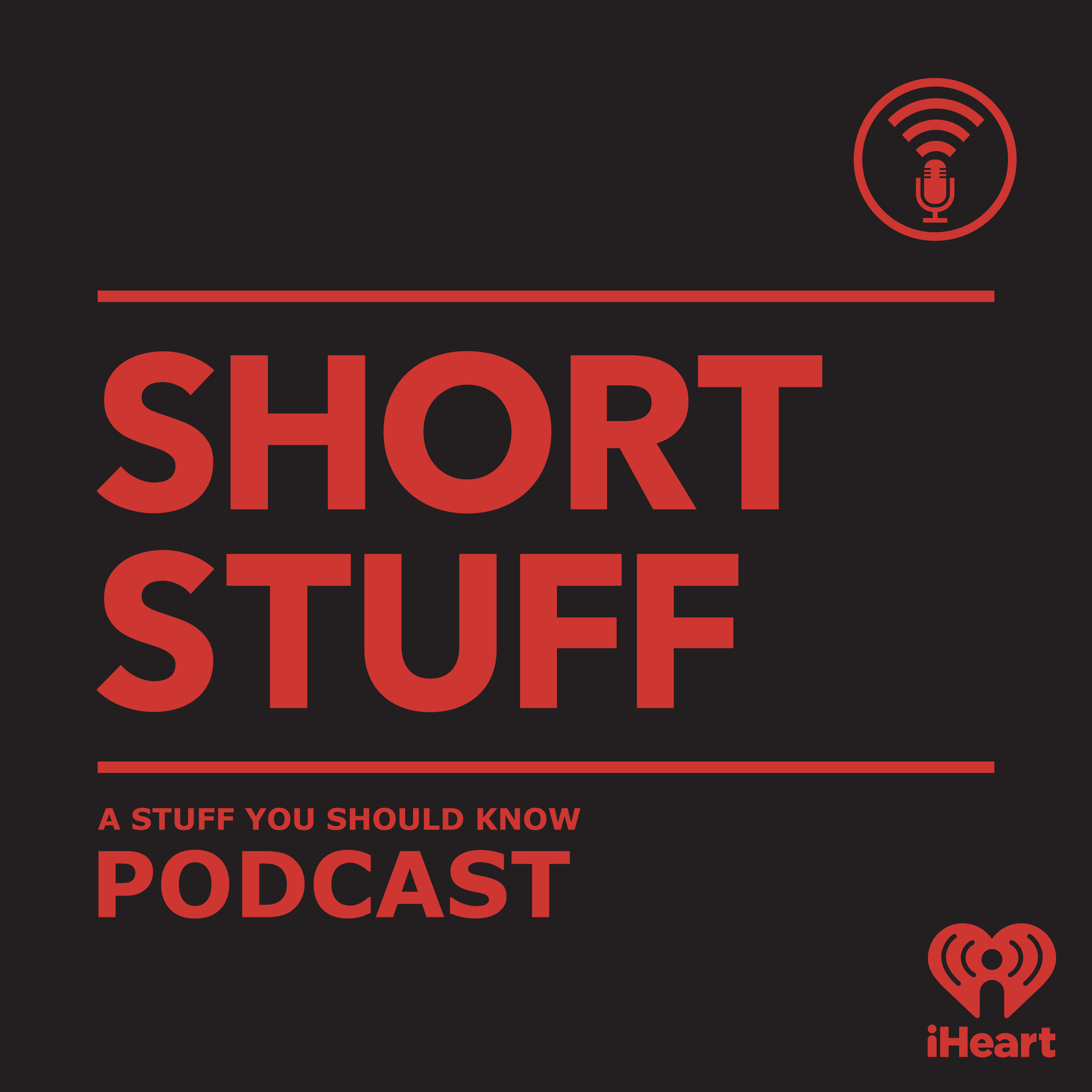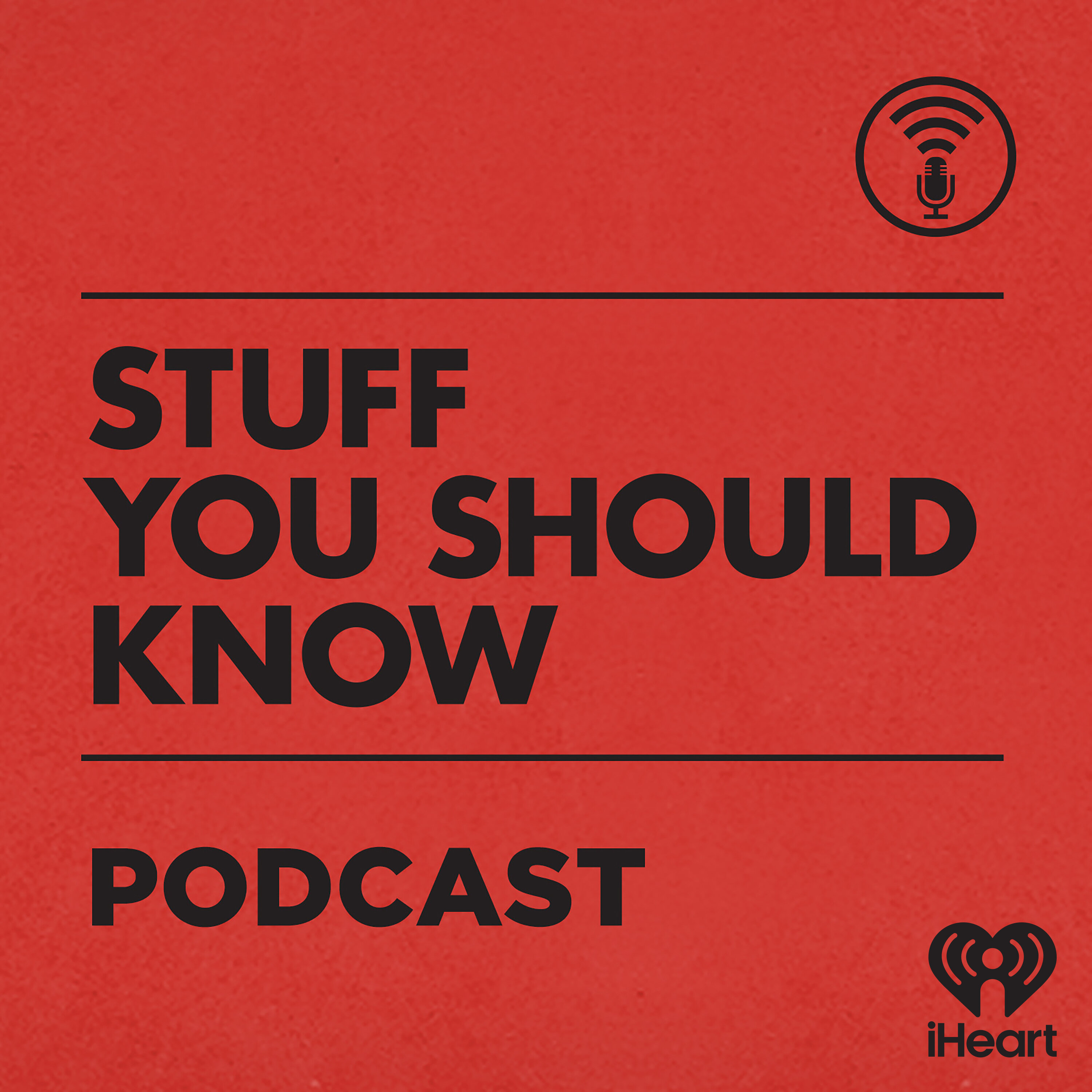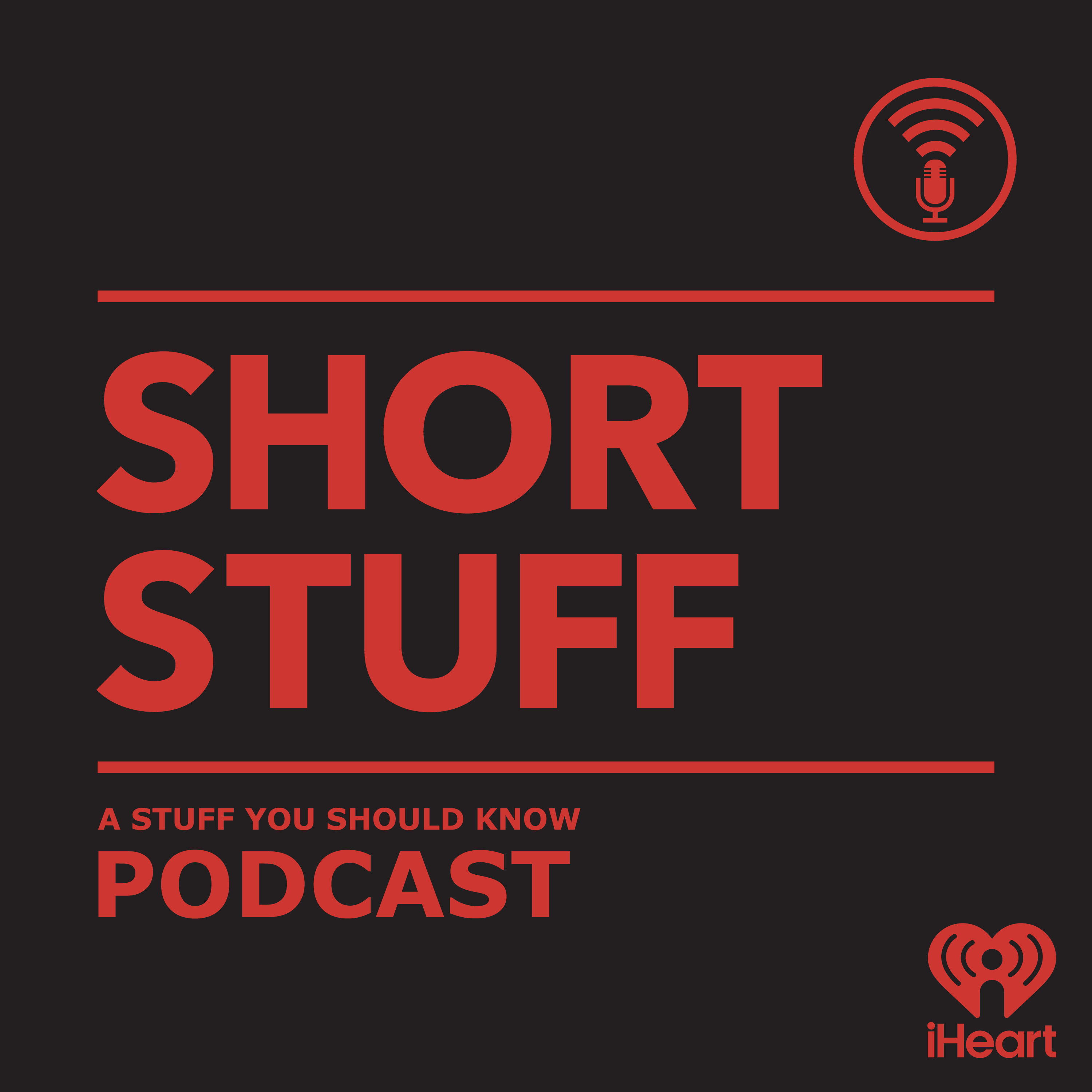Short Stuff: 8 Track Cartridges
8 tracks were during vinyl, but preceded cassettes. Why? So people could listen to their music on the go. Check out this antiquated medium today.
See omnystudio.com/listener for privacy information.
Press play and read along
Transcript
Speaker 1 This is an iHeart podcast.
Speaker 2 Want Black Friday prices without the crowds? Lowe's gets it. Shop their early Black Friday deals and beat the rush.
Speaker 2 $99 is all you need to grab a select seven-foot pre-lit artificial Christmas tree for the holidays. And don't sweat what gifts to get, Dad.
Speaker 2
They have up to 40% off select tools and accessories going on now. That's how Lowe's celebrates Black Friday early.
Selection varies by location while supplies last.
Speaker 3
Hey, and welcome to the Shortstuff. I'm Josh.
There's Chalk. It's just us.
Neither Jerry nor Dave is here.
Speaker 3 So it's Shortstuff, the Bereft Edition.
Speaker 2 That's right. I want to thank NPR, Capture.com, a website called PS Audio, a website called EverPresent, and more for the research that went into the 8-track cassette player or 8-track cartridge
Speaker 2 itself. April 11th is National 8-Track Tape Day, so we've missed that.
Speaker 2 But if you don't know what an 8-track is, it preceded
Speaker 2 the cassette tape.
Speaker 2 And we're going to get into what this thing was.
Speaker 3 Yeah, you usually wedge it in between LP record albums and cassettes because that's basically where it really popped up.
Speaker 3 In the 70s is kind of where you really associate eight tracks, but it was way older than that. Apparently, as far back as the 40s, it was essentially coming into development, right?
Speaker 2 Yeah, which surprised me.
Speaker 2 You might be wondering, like, why did we need
Speaker 2 eight tracks at all?
Speaker 2 And it's because at the time, dear listener, especially a younger dear listener, if you wanted to play the music that you wanted to hear, you could play it on your record player in your house.
Speaker 2
You didn't have a record player in your car. You had a radio that played whatever the heck they wanted.
So all of a sudden, eight tracks came along as a...
Speaker 2 a mobile version, a way to take the music that you wanted on the road, either via your car or via these awesome portable players, of which we had one of. It was a Lloyds.
Speaker 2 We had a deck in our conversion van, of course, but we had, just look up the white Lloyds 8-track portable player, and that was the very one. I found it online, and I might even get one on eBay.
Speaker 2 It brought back so many nostalgic memories.
Speaker 3 That's awesome, man. You totally should.
Speaker 3 One of my friends in high school, Mitch, not dirty Mitch with scabies, but the different Mitch. That's what I was going to say.
Speaker 3 His grandmother had a huge white Lincoln Lincoln Continental with an 8-track deck in it.
Speaker 3 And we got our hands on the Saturday Night Fever soundtrack on 8-track and we would just cruise around listening to that in that car. It was pretty boss.
Speaker 2 Skipping forward two songs at a time.
Speaker 3
Ish. Yeah.
Yes. Yeah, that's something I can't wait to talk about.
But just a little background on
Speaker 3
how this worked. It was built on...
ancient technology from the 20s and 30s, which was magnetic film, which became real-to-real film. And essentially,
Speaker 3 that is tape that has magnetized metal particles on it. And when sound is converted into an electrical impulse, the tape writer translates that into,
Speaker 3 well, it's an electromagnet. It translates it into a magnetic pulse that arranges these
Speaker 3 pieces of magnetic metal into ones and zeros. And then the whole thing is done backwards
Speaker 3
on the other end when you listen to it. This is the basis of not just A-Tracks, but cassette tapes.
But since 8-tracks came first, this is what they were built on over time.
Speaker 3 And there were a few inventions that kind of were stepping stones that led to the 8-track.
Speaker 2 Yeah, I mean, the Germans were using it in World War II. The Allies got a hold of it, and eventually it got to the music industry.
Speaker 2 And they were like, hey, we got a thing now that we can play this stuff on the road, we think, in a continuous loop.
Speaker 2 And the very first person to achieve the version that could go to market was a guy named William Powell Lear, the creator of the Learjet.
Speaker 2 Previous to this, there were some sort of housing and internal guts things that were worked out by various people. A guy named George Isch in 1953 came up with the NAB cartridge or the
Speaker 2 Fidillipak cartridge.
Speaker 2 It's also called a cart. If you ever heard of like on WKAR or Cincinnati or old radio stations, they had carts, music carts.
Speaker 2 That's what that was. These were built for radio stations.
Speaker 3 Yeah, it was short for cartridge slang, I guess you'd call it. Yeah.
Speaker 3 So that was followed up by the Muntz Stereo Pack.
Speaker 3 And it was created by Earl Madman Muntz, and he directly influenced the development of the A-Track because William Powell Lear was riding around in Madman Muntz's car when he was playing one of the stereo pack cartridges for him.
Speaker 3 But the thing that really kind of separated Muntz from everybody else is he's the first one to go directly to the record companies and say like, hey, let me license your music and put them on this new format and let's start getting it out there.
Speaker 3
And like I said, William Powell Lear was like, this is a great idea. I'm going to build on this and create a longer playing version of it.
And I'm going to call it the eight track.
Speaker 2 Yeah. And then Vinta Jet.
Speaker 2 Yeah.
Speaker 2 I should point out too quickly,
Speaker 2 and this can't be a coincidence, but Earl Madman Muntz was the creator of that cart.
Speaker 2 If you're a Cohen Brothers fan and a fan of the movie Barton Fink, you will know that John Goodman's character name is Carl Madman Munt.
Speaker 3 Oh, really?
Speaker 2
And there's no way that's a coincidence. No.
I don't know the correlation or if it was just
Speaker 2 they thought it sounded cool or something. Who knows?
Speaker 3 What a strange homage if it was, though.
Speaker 2 Agreed.
Speaker 2 Shall we take a break?
Speaker 3 Yes, Chuck.
Speaker 2
Yes. All right.
We'll be right back with more on the bygone era of the A-track right after this.
Speaker 2 Attention, parents and grandparents. If you're looking for a gift that's more than just a toy, give them something that inspires confidence and adventure all year long.
Speaker 2 Give them a Guardian bike, the easiest, safest, and number one kids' bike on the market.
Speaker 3 Yeah, with USA-made kids-specific frames and patented safety technology, kids are learning to ride in just one day with no training wheels needed.
Speaker 3 It's why Guardian is America's favorite kids' bike and the New York Times and Wirecutter's top pick three years in a row.
Speaker 2
That's right. My daughter has a Guardian bike and she loves it.
And that thing was really easy to put together.
Speaker 2 And get this: this holiday season, Guardian is offering their biggest deal of the year: over 40% in savings on all bikes, plus $100 in free accessories.
Speaker 2 Guardian bikes have become one of the most sought-after gifts of the season, and inventory is going fast, so don't wait. Join over a half a million families who've discovered the magic of Guardian.
Speaker 2 Visit guardianbikes.com to shop now.
Speaker 1 Tired of spills and stains on your sofa? Wash away your worries with Anibay. Anibay is the only machine-washable sofa inside and out where designer quality meets budget-friendly prices.
Speaker 1 That's right, sofas start at just $699.
Speaker 1 Enjoy a no-risk experience with pet-friendly, stain-resistant, and changeable slip covers made with performance fabric.
Speaker 1 Experience cloud-like comfort with high-resilience foam that's hypoallergenic and never needs fluffing. The sturdy steel frame ensures longevity, and the modular pieces can be rearranged anytime.
Speaker 1 Shop washable sofas.com for early Black Friday savings up to 60% off site-wide, backed by a 30-day satisfaction guarantee. If you're not absolutely in love, send it back for a full refund.
Speaker 1
No return shipping or restocking fees, every penny back. Upgrade now at washable sofas.com.
Offers are subject to change, and certain restrictions may apply.
Speaker 3 So, all of this was being developed in the 50s, I think as early as the 40s technically, but the 8-track really came into its own in the mid-60s.
Speaker 3 And the reason why is because the Ford Motor Company said, hey, everybody, have you heard of these 8-Tracks?
Speaker 3 Well, we're going to start putting 8-Track players in our 1966 model cars as a high-end option.
Speaker 3 And as more and more cars started featuring 8-Track players, 8-Track cartridges just became dominant as the form of how you listen to music outside of your home in a way that you controlled, unlike radio.
Speaker 2
Yeah, for sure. They were pretty cheap.
They were two to three bucks. The most expensive on record was the Beatles' Greatest Hits, released in 1970.
That was almost $5, $4.97, which would be...
Speaker 3 That's the nice price.
Speaker 2 Yeah, the nice price. That'd be more than $40 today.
Speaker 2 So that was, you know, that was an expensive eight track for sure.
Speaker 2 It hit its popularity in the mid-70s.
Speaker 2 And I guess we should talk a little bit about how these things...
Speaker 2
played. You know, you've got the magnetic tape that you described inside on a single reel.
And there was a little motor that pulled the tape across the audio head to make it make the sound.
Speaker 2 But you're probably, if you don't know what these are, you're probably like, what is the eight tracks? What does that even mean?
Speaker 2 Each tape had eight tracks and a sensing strip that told a solenoid coil, like, hey, a program is over, which was, you know, roughly two songs. And now it's time to switch over to the next track.
Speaker 2 So when I said you could skip ahead two songs at a time, if you hit the button, it would it would pop forward
Speaker 2 two songs roughly.
Speaker 3 So weirdly, I want to say just one thing because I don't want us to get emails.
Speaker 3
I saw in one place that it actually had four tracks, but there were two of each of the four tracks, so they were in stereo. So, two times four was eight.
I only saw that in one place.
Speaker 3 Everywhere else kind of described it as eight different tracks, like you just did, but I just wanted to put it out there. All right.
Speaker 3 So, yeah, so this whole thing, what differentiates it from cassette is that it played continuously. It was an endless loop, right?
Speaker 3 So, I guess if you pressed play, it would play the whole album over and over again until you press stop. Is that correct?
Speaker 2 Yeah. And the point is you didn't have to flip it.
Speaker 2 The downside of that is you couldn't rewind it or fast forward it except for skipping two songs ahead, but you couldn't go back two songs as far as I know.
Speaker 3
Okay. So that was kind of one of the downsides.
Another big downside is that these tracks were not.
Speaker 3 Like they just took an album and they cut it up into four equal amounts of time or eight equal amounts of time, I should say, right? So if
Speaker 3 one track could fit one and three quarters of a song, that three quarters of a song would fade out, there'd be a click, and then when the next track started, it would fade back in.
Speaker 3 And people hated that.
Speaker 2 Of course they did. That's very clunky.
Speaker 3 Understandably so. But that love of clunkiness really kind of gets across the Just the kind of attention to detail that was given to eight tracks.
Speaker 3 They, as far as technology goes, they were perfectly encompassed by what they looked like. Clunky, giant, plasticky, and just clunky, I guess.
Speaker 2 Yeah, I mean, it was interesting. They deserved to be popular for a while because it was such a revolution and to be able to listen to what you wanted to outside of your home.
Speaker 2 But the other limitations,
Speaker 2 you know, not rewinding, stuff like that, apparently the internal components would fail a lot of times.
Speaker 2 Like the cassette itself was very sturdy and long-lasting, but the little motor and stuff that would fail. Your car was famous for eating the tapes.
Speaker 2 They had a lot of downsides, but that didn't outweigh
Speaker 2 the initial upside of being able to take your music on the road.
Speaker 3 No, for sure.
Speaker 3 I mean, that was a big deal. Like, I never was like, this 8-track sucks when we were listening to Sarah Night Fever.
Speaker 3 So, I mean, it couldn't have been that bad. But I think for people who are really into music, it was probably very annoying.
Speaker 2 Yeah, well, the irony is, is that the cassette tape was introduced in 1965, kind of
Speaker 2 either kind of squarely in the middle of or just before eight tracks were at their zenith of popularity.
Speaker 2 But they weren't marketed, like bands weren't releasing music on cassettes at first.
Speaker 2 It was just like, hey, here's a cassette, and you can record yourself at home and interview your parents about what life was like in World War II.
Speaker 3 Yeah, do your own story core at home. Yeah.
Speaker 3
Yeah, so people were like, I can start taping songs off the radio with these things. And essentially, it just kind of avalanche from there.
Cassettes took over
Speaker 3 because you could fast forward, you could rewind.
Speaker 3 And even though you had to flip the cassette, the worst thing that you could possibly have to do in the world, they were way cheaper than 8-tracks too, just to produce and to purchase.
Speaker 3
So cassettes pretty quickly took over. And interestingly, this is also happening at the same time with video.
VHS tapes were overtaking Betamax and Laserdisc at the same time, too.
Speaker 2 What were you about to say? The worst thing you would have to do?
Speaker 3 That was an addendum to having to flip a cassette tape. Oh, okay.
Speaker 2 I thought you were going to say if the tape unspooled some, you would have to put a pencil or use your pinky finger to rewind the tape and draw that magnetic tape back into the cassette.
Speaker 3 I always had to use a pinky because I never had a pencil because I wasn't a nerd.
Speaker 2 Well, I had one in my front pocket, my breast pocket.
Speaker 3 What else you got? Anything else?
Speaker 2 Just a couple of tidbits. There was a museum for a little while.
Speaker 2 There was an enthusiast named Bucks Burnett in Dallas, Texas that had a museum because he collected them, and it seems like it was open for a handful of years.
Speaker 2 The largest collector now is a guy named Gary Heitzman, who apparently has close to 100,000 tapes. He may have more than that because that was 2019.
Speaker 2 And the most, there's actually a very valuable one, Frank Sinatra.
Speaker 2 It's called Sinatra Job,
Speaker 2 Frank Sinatra and Antonio Carlos Jobim, which I bet is a great record. Yeah.
Speaker 2 Because they did a limited pressing, of course. It's scarcity that makes something valuable, and they only did 3,500 copies of that one.
Speaker 2 And if you have one of those, you can get a few grand for it, apparently.
Speaker 3 Why not?
Speaker 3 What are you going to do? You're not going to do anything to look at it. You might as well sell it.
Speaker 2 Yeah, get one of those Lloyds players and put that strap over your shoulder and go down the street rocking it.
Speaker 3
I found another player, too, that I would actually like. It was made by Panasonic.
It was called the Dynamite Plunger, portable 8-track player.
Speaker 3 And the reason why is because it had like a, like the handle was like on a rod coming off of it.
Speaker 3
And then it had like a, well, the thing that you gripped, and it looked like kind of a dynamite plunger. It was neat.
It came in yellow and all sorts of great colors.
Speaker 2 I'm looking it up because I got to see what you're talking about.
Speaker 3 So, yeah, there was one for sale on
Speaker 3 those. Okay.
Speaker 2 Yeah, those are rad, man. Those are awesome.
Speaker 3 If I got into 8-Tracks, I would, I would definitely buy one of those, but I'm not into 8-Tracks, so I'm not going to.
Speaker 3 Yeah.
Speaker 2 I mean,
Speaker 2 there's no reason to. Like, people are into vinyl still because the Fidelity is so great.
Speaker 2 There's really no reason to buy 8-Trex now unless you just want a little walk down memory lane of a sort of a cruddier version of everything else.
Speaker 3 Right, right.
Speaker 3 Well, I guess since we started walking down memory lane, we just walked away from the short stuff, right?
Speaker 2 Yeah, I guess that means it's out.
Speaker 1 Stuff You Should Know is a production of iHeartRadio. For more podcasts on iHeartRadio, iHeartRadio, visit the iHeartRadio app, Apple Podcasts, or wherever you listen to your favorite shows.



